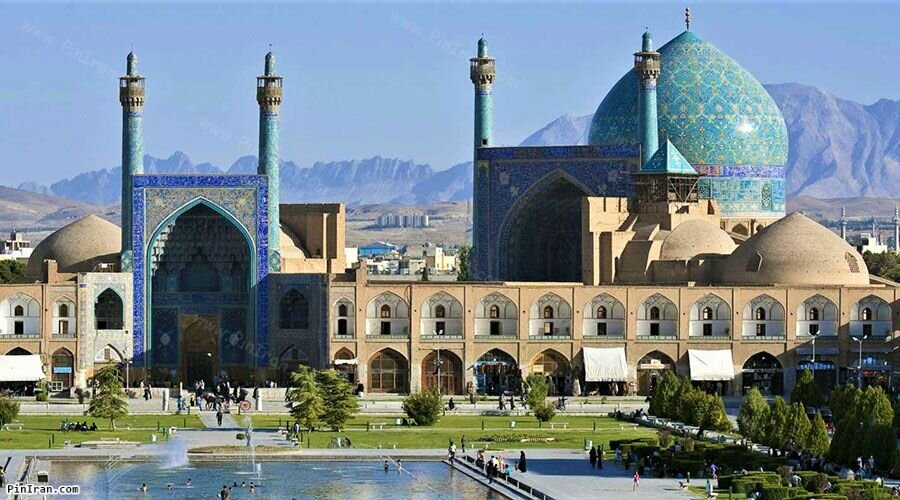Imam Mosque restoration enters final stage

TEHRAN – A masterpiece of Islamic architecture, Imam Mosque has entered its final stage of restoration, more than ten years since work began.
Imam Mosque, which is impressive because of its sheer size and incredible decorations, stands tall at the southern end of UNESCO-registered Naghsh-e Jahan Sq. (Imam Square) in Isfahan, central Iran.
“In the most optimistic case, the restoration of the dome of the Imam Mosque will be completed within the next month,” ILNA quoted the director of the UNESCO site as saying on Friday.
“At present, portions 15th and 16th (of the floral dome) are being restored at the same time, and about two to three (square) meters have remained,” Fariba Khatabakhsh said.
“Moreover, the scaffolding will be opened after a final inspection of the dome is carried out.”
Elsewhere in her remarks, the official said that restoration of Sheikh Lotfollah Mosque’s iconic dome has been stopped due to the death of one of its old hand restorers due to corobavirus infection.
Restoration of the creamy dome has been one of the most challenging and controversial renewals in the field of cultural heritage.“We are consulting with several other masters to continue work. . . but we have not yet found the right person so far.”
Consequently, the restoration of the dome has come to a standstill till a qualified master is hired, the official added.
Restoration of the creamy dome has been one of the most challenging and controversial renewals in the field of cultural heritage to some extent that almost every stage of it has been attacked by some critics and cultural heritage enthusiasts.
The criticism has involved various aspects from the variation in coloration, and the method used to reinstall the restored tiles or the newly-made replicas to a phenomenon that snow did not cover some restored parts of the dome.
A very scenic huge entrance portal leads visitors to Imam Mosque whose courtyard walls feature sunken porches framed by seven-colored tiles of deep blue and yellow. Each iwan leads into a vaulted sanctuary covered with particularly fine floral motifs on a blue background. Some visitors say each part of the Imam Mosque is a masterpiece that leaves a lasting impression.
On the other side of the square stands the very delicate Sheikh Lotfollah Mosque. Constructed between 1603 and 1619 during the reign of Shah Abbas I, the mosque was dedicated to the ruler’s father-in-law, Sheikh Lotfollah, a revered Lebanese scholar of Islam who was invited to Isfahan to oversee the king’s mosque (now the Imam Mosque).
The exterior panels boast collections of arabesques and floral designs that have become a signature motif of the masterpiece. The portal itself contains some stalactite-type stone carving used to decorate doorways and window recesses with rich concentrations of blue and yellow motifs. Inside the sanctuary, there are thousands of mosaics that adorn the walls and its extraordinarily gorgeous ceiling that features a series of shrinking, yellow motifs, itself a masterpiece of design. Photography is allowed but using a flash is not.
Half the world?
Soaked in a rich history, Isfahan was once a crossroad of international trade and diplomacy in Iran and now it is one of Iran’s top tourist destinations for good reasons.
It is filled with many architectural wonders such as unmatched Islamic buildings, bazaars, museums, Persian gardens, and tree-lined boulevards. It's a city for walking, getting lost in its mazing bazaars, dozing in beautiful gardens, and meeting people.
Isfahan is renowned not only for the abundance of great historical bridges but also for its ‘life-giving river’, the Zayandeh-Rood, which has long bestowed the city an original beauty and fertility.
The city has long been nicknamed as Nesf-e-Jahan which is translated into “half the world”; meaning seeing it is relevant to see half the world. In its heyday, it was also one of the largest cities in the region with a population of nearly one million.
The cool blue tiles of Isfahan's Islamic buildings, and the city's majestic bridges, contrast perfectly with the encircling hot, dry Iranian countryside.
Imam Square is hemmed on four sides by magnificent buildings: to the east, the Sheikh Lotfollah Mosque; to the west, the palace of Ali Qapu; to the north, the portico of Qeysarieh; and to the south, the eminent Imam Mosque.
“The square was at the heart of the Safavid capital’s culture, economy, religion, social power, government, and politics. Its vast sandy esplanade was used for celebrations, promenades, and public executions, for playing polo and for assembling troops,” according to the UNESCO website.
Right at the northern limit of the Imam Square, one will find “Qeysarieh Gate”, which leads to the unique and unforgettable “Grand Bazaar of Isfahan”. This vaulted marketplace is one of the largest and most labyrinthine bazaars in the country. Shops offering handicrafts, souvenirs, jewelry, silverware, traditional ceramics, and authentic Persian carpets.
Modern Isfahan is now home to some heavy industry, including steel factories and a nuclear facility on its outskirts, however, its inner core wants to be preserved as a priceless gem. The city is also home to a gigantic, professional, and state-of-the-art healthcare city, which is a major destination in the realm of medical tourism.
AFM
Leave a Comment